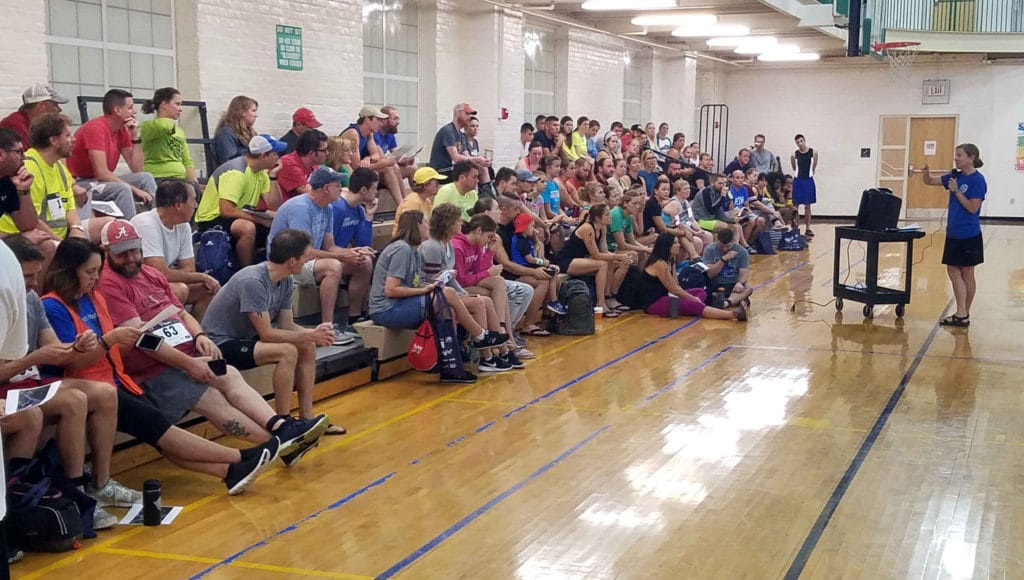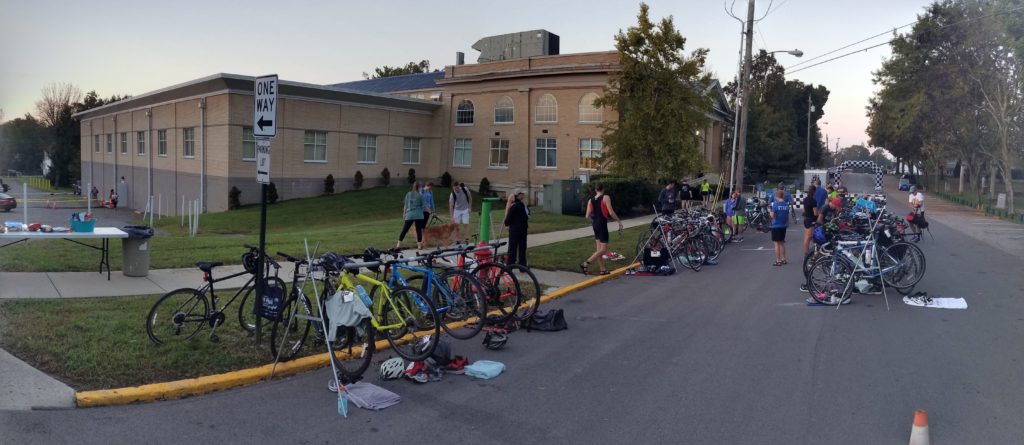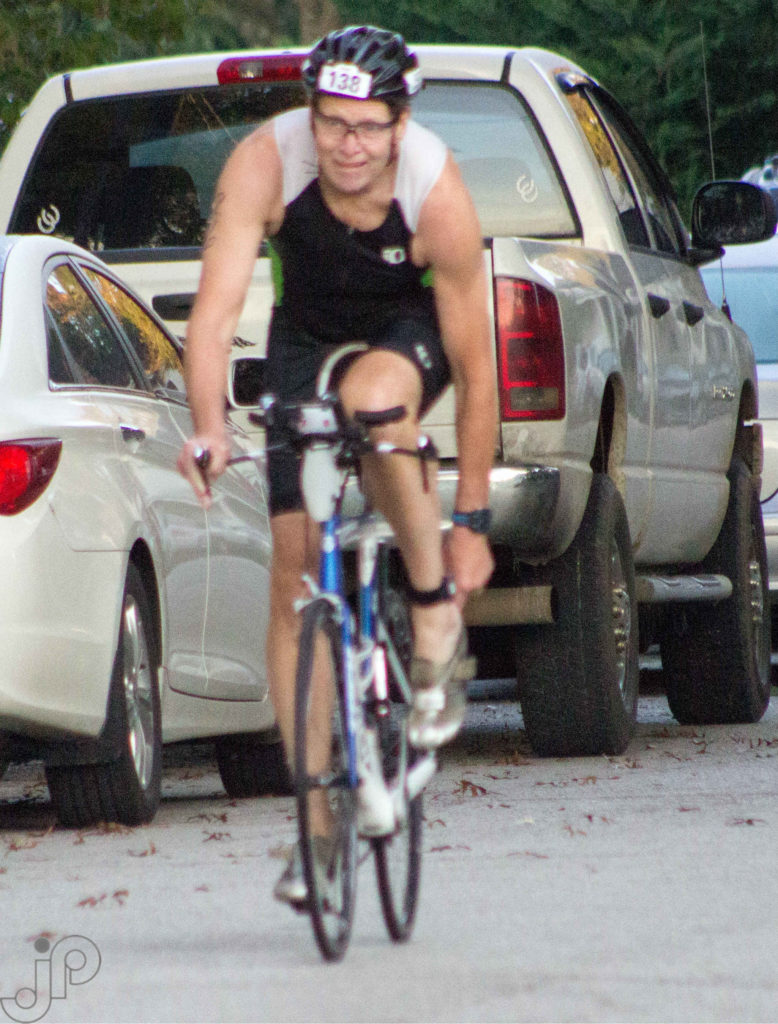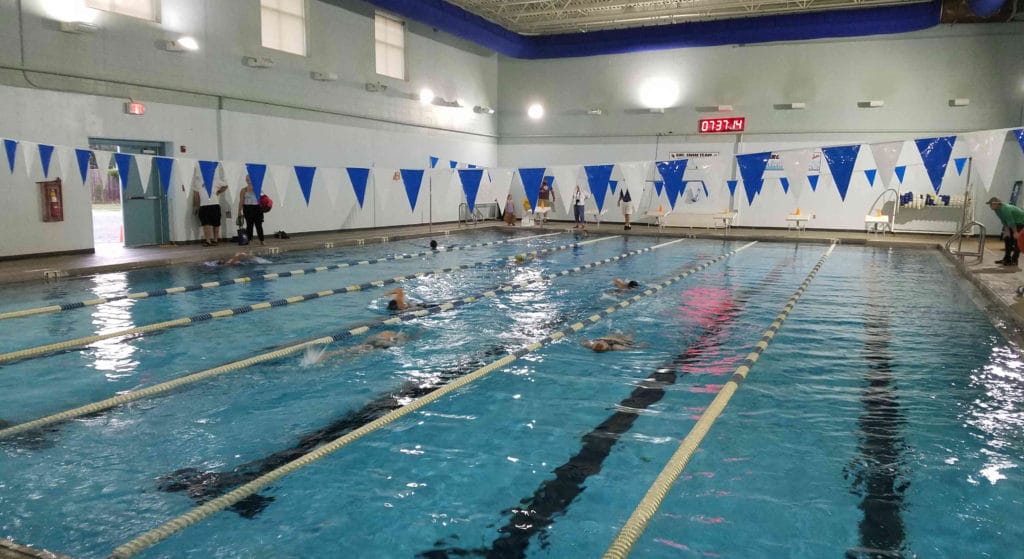Triathlon Across the USA: State #41 – Kentucky
Winchester, Kentucky; October 6, 2018 – WinSprint 2018, Winchester-Clark County Recreation Center.
Our Kentucky triathlon was a small, yet challenging, competitive, and well-run race.
So, if competing in a triathlon with several hundred or even thousands of participants is intimidating, don’t let that stop you. Choose one that fits your goals and comfort zone.
A Road Trip to Celebrate our 45th Wedding Anniversary
I learned about the WinSprint Triathlon on a favorite website, Running in the USA, while searching for triathlons in the southeastern states. Joy and I used the site to put together a string of five triathlons on five consecutive weekends to get us closer to our goal of a triathlon in each of the 50 states.
The Kentucky triathlon also coincided with our 45th wedding anniversary.
Getting to the Kentucky Triathlon
After the North Carolina Triathlon on the previous Saturday, Joy and I took a leisurely path to Daniel Boone country in northeastern Kentucky. On the way, we toured portions of western North Carolina and communities around the Great Smoky National Park in eastern Tennessee.
Actually, this was our second time in Kentucky during the road trip. The first visit was between the Ohio and Tennessee triathlons in the second week of the trip.
During the earlier visit to Kentucky, we tried our hand at tent camping. Unlike our time in Ohio, this camping was without the rain, in Big Bone Lick State Park in northwestern Kentucky.
3rd WinSprint Triathlon
The WinSprint Triathlon is organized and managed by the staff of Winchester – Clark County Recreation Center (WCCRC). The center is housed in the former site of Southeastern Christian College.
The triathlon doubles as a fundraiser for the purchase of bikes for the WCCRC annual Bicycle Rodeo. According to the WCCRC website:
“Last year we purchased and gave away 26 bikes! We hope to give away even more during our 2018 event and appreciate your support in helping make this a reality!!”
The 2018 WinSprint Triathlon included six categories of race, all involving sprint triathlon distances:
- Sprint triathlon with road biking
- Sprint triathlon with stationary biking in the fitness center
- Relay versions of the road and stationary bike events
- Duathlon (bike and run; no swim) versions of the road and stationary bike events
Distances for the individual legs of this sprint triathlon were:
- Swim: 0.23 mile (400 yds)
- Bike: 6.2 miles (10 km)
- Run: 3.1 miles (5 km)
Filled to Capacity
According to April S. of WCCRC, the number of participants in the WinSprint Triathlon has grown each year. Starting with 40 participants in 2016, the race’s first year, the number of racers jumped to 80 in 2017, its second year.
In this, the third year, registration exceeded the initial cap of 100 participants set by recreation center management. The cap was based on the capacity of the WCCRC facility and the number of participants that could complete the event within the half day allotted to it.
While Clark County was well represented among the participants, about 60% of the participants came from outside the immediate area.
The race had a family-friendly feel to it with lots of children visible on race morning. A special feature of this race was the availability of free daycare. Race organizers provided this for parents who needed their children watched while they raced.

WinSprint Triathlon Transition Area
Another unique feature of this race, one that I like, was the lottery for the position (bike rack number) within the transition area. During packet pickup on race morning, triathletes selected a colored piece of paper with a number. Mine had the number 12 on it.
The number on the paper corresponded to the number on the rack on which we placed our bikes. The lottery had two benefits.
First, it controlled the number of bikes on each rack. This ensured that each racer had roughly the same space in which to set out their gear within the transition area.
The second benefit was that it prevented a rush on race morning to get the best locations in the transition area. Unlike most triathlons, the bike out/in and the run out locations were on the same end of the transition area. With this arrangement, there was an advantage, albeit small, to having one’s transition space near the bike out/in end of the transition area.

Swim
The swim was organized in waves. Waves began at 15-minute intervals. Two swimmers were assigned to each of five lanes of the 25-yard long pool. A sixth lane remained open for swimmers who required more than the allotted 15 minutes to complete the swim.
Swimmers swam eight laps (sixteen lengths). Volunteers who counted each swimmer’s laps notified each person when they were beginning their last lap and when they had completed eight laps.
With their swim complete, athletes either left the building for the outdoor transition area (using the door in the picture below) or, if they were taking part in the stationary bike event, left the swim area for a nearby room containing the stationary bikes.
Bike
There were two unique features of the WinSprint Triathlon:
- It had the shortest bike leg of any of the more than 40 triathlons I have completed to this point.
- It was the first to include a stationary bike option for the bike leg.
For the stationary bike option, the rider used a bicycle within the fitness center to ride the 6.2 mile (10 km). Of course, there were no hills and there was no wind working for or against the rider while on the stationary bike.
Not surprisingly, times on the stationary bikes were less than those on the road bikes. The fastest bike split (time on the bike) for an individual sprint triathlete competing in the stationary bike event was 13:16. This compared to the fastest bike split of 17:31 for the road bike event.
Out on the Road
The temperature on the bike course was comfortable, in the low 70s °F. The course left the transition area following city streets to Boonesboro Avenue, a county highway that led southwest out of town toward the turnaround at George Rogers Clark High School.
Upon reaching the entrance to the High School, I turned into the parking lot. There were no other bikers around me, though there were plenty of volunteers whose instructions I thought I followed correctly.
I continued straight ahead, riding counterclockwise around the school building. Passing another volunteer in a parking lot behind the school, I continued up the hill leading to the exit of the property and back toward the highway.
While riding the last few hundred yards to the exit of the school grounds, I met other bikers going in the opposite direction from me.
I am still not sure if I followed the right course or if I should have gone clockwise around the building. The bike course map on the race website did not show this detail. Either way, the distance was the same.
Triathlon tip: One strategy that helps to shave a few seconds off the overall race time is to leave my bike shoes connected to the pedals. Following a few pedal strokes after mounting the bike, I coast and slip my feet into the bike shoes. This requires practice, so don’t plan to try this for the first time on race day.

Run
The run course took us through the Holiday Hills neighborhood west of the Recreation Center. I learned from April that the course would be hilly. It didn’t disappoint. In fact, there were few flat sections on the course, even though none of the hills were especially long or steep.
There was plenty of moral support and encouragement to help us along the course. There was also water.
In fact, I still chuckle each time I recall the young girl who passed out water at the mid-point of the run course. As I took the cup of water, she told me that I could throw my water cup on the ground.
I asked her who would pick up the cup if I threw it on the ground. Without hesitating, she gave me the answer. “My mom.”
Smiling, I tucked the paper cup into the pocket on the back of my triathlon suit and headed toward the finish.
Time to Head Home
After crossing the finish line and turning in my timing chip, I downed some liquid refreshment and a banana. After stowing the race gear back in the van, we headed to the hotel for a shower.
With the fifth of the five fall triathlons complete, we began our return home.
Firsts at the Kentucky Triathlon
- First triathlon at which daycare was provided for participants.
- Shortest bike course.
- First triathlon with a stationary bike option.
Large or Small?
What size of triathlon do you most prefer? Number of participants? Distance? Share your thoughts in the Comments below.


